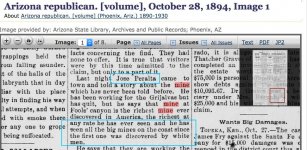Hal Croves
Silver Member
- Sep 25, 2010
- 2,659
- 2,699
The history of the "Peralta" Frank Fish map is far from a certainty. In legal terms this would be considered a questionable "chain of custody" or possession. It could have been created as a work of art. Frank Fish claimed to have obtained the original in Mexico during a trip there, and unfortunately the creation of treasure maps has a long history of being a regular little cottage industry in Mexico, to sell to the unwary.
Matthew also wrote
I see that Steve already addressed this but in addition, the Fish map was actually published in a magazine in 1959, and has been in public circulation for six decades. In that time period, many, many treasure hunters have used the map to attempt to locate treasure or mines without success. That point alone is a red flag that it is probably not the genuine article.
Matthew also wrote
As religions are basically dealing with the supernatural rather than temporal matters, faith is the key ingredient involved, while for temporal matters faith is not the only factor we must rely on.
Matthew also wrote
You are certainly welcome to your opinion and beliefs. I can't prove the Frank Fish map is false, however the record on it so far has produced nothing but disappointments for those whom have attempted to use it for the purpose it is supposedly created for. As Steve once put it, and I am paraphrasing but we can't put a lot of trust in treasure maps and waybills that have been in public circulation for a long time. If these guides were genuine someone would be on the evening news showing their amazing discovery before we could get the truck loaded to go. We are not exactly the first treasure hunters to come along after all.




Could you point to that 1959 article?
I think that you wrote a fair response but since 1939, there hasn't been any motivation or incentive for the lucky few to step forward, if there are any.
Treasure Trove Hunting
A treasure trove is defined as money, gems, or precious worked metal (in the form of coins, plate, bullion, etc.) of unknown ownership. Not included are recent vintage coins, locatable minerals, or archeological resources and specimens. Searching for such treasure must be authorized by a permit. Applications for Treasure Trove Permits are evaluated on a case-by-case basis; approval requires that evidence of treasure is of such a character that a person of ordinary prudence would be justified in the expenditure of labor and funds, with a reasonable possibility of success. Permits are issued for a specific number of days and the site is subject to inspection.
https://www.fs.usda.gov/detail/tonto/specialplaces/?cid=fsbdev3_018726




 lol...One day...Y si dios quiere...I am a simple poor man who does not need very much...So who knows IF I will ever try to return to any of the areas of which I speak...Heck...Someone may have stumbled upon some of them by now and they may even have filed a claim on said areas...I don't want to be a claim jumper...I just hope that, IF anyone has found any of the areas in question, they don't end up in pieces in plastic bags...I heard that some of the cartels are chopping people into pieces and mixing the body parts up and putting parts from several people into different bags...Or so I've heard...Has anyone else heard any such tales
lol...One day...Y si dios quiere...I am a simple poor man who does not need very much...So who knows IF I will ever try to return to any of the areas of which I speak...Heck...Someone may have stumbled upon some of them by now and they may even have filed a claim on said areas...I don't want to be a claim jumper...I just hope that, IF anyone has found any of the areas in question, they don't end up in pieces in plastic bags...I heard that some of the cartels are chopping people into pieces and mixing the body parts up and putting parts from several people into different bags...Or so I've heard...Has anyone else heard any such tales





